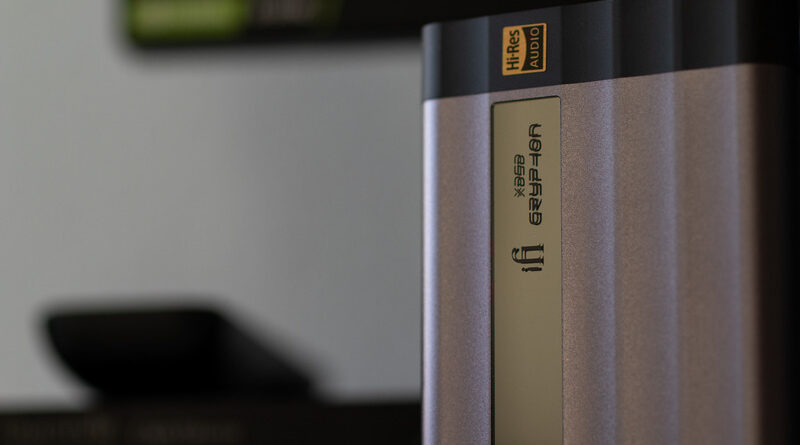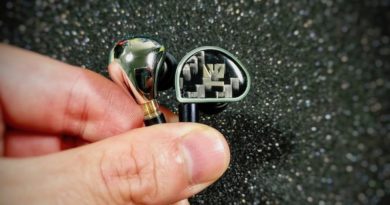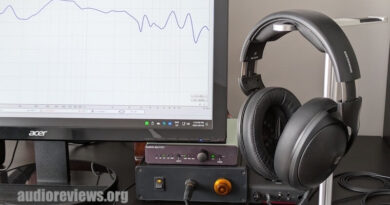iFi Audio xDSD Gryphon Review (1) – Swiss Army Knife
Pros — Excellent build quality and industrial design
– Moderately powerful balanced output
– xBass and IEMatch features are handy
– Warm-neutral tuning that doesn’t sacrifice transparency
– MQA hardware-level decoding
– Excellent BT support
Cons — The Gryphon can feel unwieldy when paired with large phones
– Not powerful enough to drive planars
– Slight hiss with extremely sensitive IEMs (without IEMatch)
– Not the best battery life when driving power-hungry cans
– High recharge times
In this Article
INTRODUCTION
iFi Audio has been hard at work lately as they are continually refreshing their existing models whereas throwing in a new model or two to further flesh out their lineup.
The iFi xDSD Gryphon is their latest portable DAC-Amp and in terms of pricing it sits below the venerable micro iDSD Signature. In terms of features and use-case though, the Gryphon seem to be an evolved xCAN. Moreover, the circuitry has similarities with the desktop all-in-one iFi Neo iDSD (reviewed here).
So, the Gryphon appears to be a mish-mash of several past and present iFi products and seem to have taken the best bits from them, at least on paper. Let’s see if the real-world performance stacks up accordingly.
Note: the ratings given will be subjective to the price tier. iFi Audio was kind enough to send me the xDSD Gryphon as a loaner via WOD Audio.
Earphones/Headphones used: Dunu Zen, Earsonics ONYX, Campfire Audio Holocene, Sennheiser HD650, ZMF Atrium, Final Sonorous III.
Firmware versions: 1.45
Price, while reviewed: 600 euros. Can be bought from WOD Audio.
PHYSICAL THINGS AND USABILITY
PACKAGING AND ACCESSORIES
iFi Audio went for a minimalist package with the Gryphon. You get the essentials: a USB type-C to type-C cable (for connecting to phones), a USB type-C to lightning cable (for connecting with iPhones), and a type-C to USB type-A cable for charging. Alongside, you also get a felt carrying pouch.
BUILD QUALITY
Build quality of the xDSD Gryphon is excellent. The housing is sandblasted aluminum with a wavy pattern on top. The volume pot is also color-matched and has distinct “steps” when rotated.
There are two buttons on the right side of the volume pot (xBass II/xSpace switch, and input selector respectively) and two headphone outputs on the left side (4.4mm balanced and 3.5mm single-ended). The volume pot has good feedback when rotated but the press feedback is a bit mushy.
The bottom of the device is extremely busy. From the left, first up is the XBass II adjusting switch. You can tweak the sound of the bass boost or the stage expansion here. Then, there are two type-C ports, one for charging and another for connecting to external devices. Underneath the charging port is a charge indicator LED.
Next to that is the coaxial/optical input, which is rare to find in device of such class nowadays. Finally, there are the 4.4mm and 3.5mm analog input/line-output. It is a variable line-out, which means voltage needs to be adjusted via the volume pot. You can use the Gryphon as a standalone DAC and pre-amp if needed.
The volume pot also acts as a power button and has an LED on top to indicate a range of SPLs (Sound Pressure Level). Another LED on the side also shows the current sample rate and file format. The following image shows all the colors and their corresponding sample rate or format.
Engaging either xBass II or PowerMatch lights up the tiny white LEDs beside the button. At the bottom there is the IEMatch switch that can select between the single-ended or balanced output. Finally, at the top faceplate resides the SilentLine OLED display which can be used to modify settings and cycle between inputs etc.
Overall, excellent build quality with no noticeable room for improvement.
HANDLING
The xDSD Gryphon, at 215 g, is not too substantial in terms of weight. However, due to the 75mm width can be awkward to hold in hand. This becomes more noticeable when you’re stacking the DAC/Amp with a large phone (most modern phones are large anyway).
As a result, I preferred to use the Gryphon with my laptop in wired mode, and while on-the-go, I paired via Bluetooth with my phone. Fortunately, the aluminium chassis provides decent amount of grip, so stacking is possible.
BATTERY LIFE
Clocking at around 8hrs of playback time, the battery life on the Gryphon is decent if unremarkable. This figure goes down further if you drive high impedance dynamics or use it over BT for long periods.
The 3600mAh battery pack could have been increased for higher playback times, but then the device would become thicker. Recharging takes about 5 hours on a typical phone charger, which is extremely high. I wish iFi employed a fast charging circuit because this recharge time means you can’t just quickly top it off once the battery empties.
INTERNAL HARDWARE
iFi Audio are most comfortable with using the BurrBrown chipset and here it appears again on the xDSD Gryphon. This is the same DAC chip that appears in the flagship Pro iDSD Signature (albeit in a quad-DAC config). The BB DSD1793 chipset offers native DSD encoding and with the updated XMOS controller can now decode MQA files at a hardware level. This feature, admittedly, is of little use to non-TIdal HiFi users but it doesn’t hurt to have an extra feature.
The potentiometer is fully analog, thus not facing some of the limitations that digital potentiometers may have. However, being analog in nature, it may degrade over time. The switches used are all from ALPS, . The amp sections remains unchanged on paper, with quad JFET OV4627 op-amps (customized for iFi Audio). The amp circuit also uses a dual-mono design for the balanced output.
Other extras include the xBass feature which is an analog EQ and mostly aims to “fix” the sub-bass roll-off issue on open-back headphones. In reality, many open-back headphones suffer from distortion in those regions and applying an EQ might cause further distortion and clipping. The other feature is the iEMatch switch that adds additional resistance to the signal path for highly sensitive IEMs, blocking hiss in the process.
As for the xSpace, it adds a sense of space to the sound that doesn’t sound artificial or overdone. I found the implementation to be tasteful with IEMs especially so give that one a try. The BT5.1 is one of the highlights of the product and has LDAC support. iFi also uses a new proprietary PureWave topology where they go for a dual-mono setup with shorter signal paths than their previous designs.
Speaking of power outputs, the xDSD Gryphon outputs 1W @ 32ohms from the balanced out and 320mW @ 32ohms from the single-ended output (which also supports their proprietary S-balanced tech). The voltage swing can go as high as 6.7Vrms from the balanced out (with a 600ohm load) and this comes handy when driving high impedance dynamic driver headphones. Output impedance is lower than 1ohm on both (with IEMatch turned off).
The internal components are all high quality as expected. TDK/Murata/Panasonic/Kemet caps, and FET-based switching to mute those annoying “pops” you encounter on some DAC/Amps. The PCB design is excellent and the components are high quality so I have no qualms about the internals of the Gryphon.
XDSD GRYPHON TONALITY AND TECHNICALITIES
The general sound of the iFi xDSD Gryphon can be summarized as warm-neutral. It has the characteristic iFi Audio warmth with smooth treble and an engaging, transparent midrange. The bass is mostly neutral but can be pushed higher with the xBass switch. Depending on the xBass mode, the bass can sound atmospheric (with slight bloom and reverb) or mostly focus on increasing punch and slam.
Staging and imaging is excellent on the xDSD Gryphon. No, they won’t rival their desk counterparts, but given the portability it is better than most DAPs in this range. Treble also doesn’t exhibit the rather common “glare” you find in many dongles these days. There is a sense of naturalness to the signature that can be addicting. Despite this slight laid-back delivery, the Gryphon is very resolving, bringing out subtle nuances from tracks and doing justice to flagship IEMs with their detail retrieval capacity.
One thing to note is that changing the firmware can bring subtle changes to the sound due to changes in reconstruction filter. I used both the GTO and non-GTO firmwares. The latter had a more laid-back treble and had a slightly wider stage, while the former had slightly more up-front mids and more macrodynamic punch. Biggest difference happens with MQA files on the GTO firmware, so if you are using Tidal, this is the recommended one.
Overall transparency and resolution was very good, with no noticeable roll-off in the upper-treble frequencies. Separation was very good as well, though the likes of Chord Mojo2 does that better. The background hiss with sensitive IEMs is also not distracting, as once the music starts playing you don’t even notice it. Moreover, there is IEMatch to take care of hiss, though that tends to modify the frequency response of some multi-BA IEMs so keep that in mind.
PAIRING NOTES
Sennheiser HD650
The Sennheiser HD650 is one of the few headphones that scale according to the source quality. On paper, the xDSD Gryphon has the required voltage swing to power it, and it does sound good. The HD650 got loud from the balanced out and had some of the dynamics it can display on a more powerful amp. Separation was good as well.
However, you still don’t quite get the “magic” that happens when you connect the HD650 to OTL amps like Feliks Euforia. Granted, that thing is a behemoth and costs over 3 grands. For the size and price, I think the Gryphon did a good job with the HD650, but those headphones can scale higher.
Final Sonorous III
Final Sonorous III is a closed back pair of headphones and are very efficient. Despite the efficiency they are quite transparent to source quality. The Gryphon drove them excellently with no loss in dynamics and the bass was quite pleasant. The mids were transparent, with no evident peaks in the upper mids that tends to creep up on some sources.
I would call the xDSD Gryphon an excellent pairing for efficient dynamic driver headphones.
ZMF Atrium
The ZMF Atrium is a similarly high impedance dynamic driver as the HD650. Their pairing with the Gryphon was surprisingly good. I got great separation, the bass was not loose and had good amount of punch, and the staging was excellent.
The Atrium can scale much higher (with the aforementioned Feliks Euforia for example) but for portable use, the Gryphon are absolutely adequate. Just make sure you use the balanced out.
Hifiman HE-6se V2
On the planar magnetic side, we have the Hifiman HE-6se V2. With 82dB @ 50 ohms efficiency, these are one of the hardest to drive headphones in the entire planet. The Gryphon failed to get them loud enough to be enjoyable, even from the balanced output. These headphones are notorious for bringing amps to their knees and sadly xDSD Gryphon isn’t designed for such workloads.
Dunu Zen and Dunu Zen Pro
The Dunu Zen and Zen Pro both exhibited slight hiss from the balanced out of the xDSD Gryphon. However, the overall sound was quite pleasant. The pairing was very resolving without being “on-your-face”. I especially liked how the Gryphon took some edge off of the OG Zen, which can be a bit peaky near the upper-mids.
In general, the xDSD Gryphon pairs really well with most if not all IEMs. The warm-neutral yet transparent signature complements somewhat analytical headphones and even works well with warmer sounding gear. On the other hand, I would not recommend it for power-hungry planar magnetic headphones, or very high impedance dynamic driver headphones due to the relatively lower voltage swing.
SELECT COMPARISONS
vs iFi micro iDSD Signature
The micro iDSD Signature (reviewed here by Alberto) is priced slightly higher than the xDSD Gryphon, but has a much more powerful amp section and a Dual-DAC implementation.
In terms of physical appearance and handling, the iDSD Signature is noticeably larger and heavier. It’s also more of a transportable DAC-Amp than a portable one. The xBass implementation on the Gryphon is better and offers more fine-tuning. The display is also handy.
Meanwhile, the micro iDSD can replace some desktop amps with the incredible 4W @ 16ohms output. This one is meant to drive full-size cans and apart from the likes of Hifiman HE-6se V2 and Abyss 1266TC, it can drive most headphones including some planars.
On the other hand, the Gryphon offers more flexible connectivity and pairs better with IEMs, which are easily over-driven by the micro iDSD Signature. Background hiss was also comparatively lower on the xDSD Gryphon. Soundwise, the micro iDSD Signature goes for a meatier, denser presentation, whereas Gryphon has better clarity and somewhat laid-back signature.
In short: if your primary use-case is IEMs, then go for the Gryphon. It’s more portable, easier to pair with phones, and there is lower chance of over-driving the earphones. For headphone usage the micro iDSD will be a better fit.
CONCLUDING REMARKS
The iFi xDSD Gryphon offers a lot of bells and whistles, and in a sense is more versatile than their desktop DAC-Amp, the Neo iDSD. iFi managed to miniaturize the circuitry in a pocket form, while offering the same output power. That’s remarkable indeed. I wish the Gryphon offered a fixed-voltage line-out but that’s a minor nitpick.
The biggest gripe, for me, would be the slow recharge time. For such a moderate-capacity battery I expected lower recharge time. I had to charge the Gryphon every 3 days during review, and if I forgot to charge it overnight then I couldn’t take it out during commute. Bummer.
Nonetheless, those looking for a battery-powered DAC/Amp for all-purpose use via BT or USB, the xDSD Gryphon is pretty much one of the best under $1000. You do not get absolute output power for headphones, but you get excellent transparency in the sound and fantastic pairing with IEMs irrespective of tuning of driver config. Recommended.
MY VERDICT
4.5/5
One of the best portable DAC-Amps in its price-class for powering IEMs and moderately efficient headphones.
DISCLAIMER
Get it from WOD Audio.
Our generic standard disclaimer.
PHOTOGRAPHY
You find an INDEX of our most relevant technical articles HERE.







